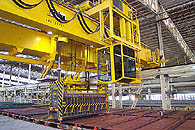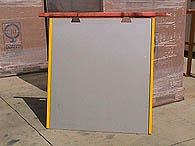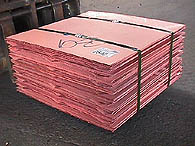
ISA Process
1979
copper refining process
Copper that is used in electrical applications has to be very pure, containing more than 99.9% pure copper. To produce such pure copper, an electric refining process is used. Copper that is only 99.7% pure is made more pure by placing sheets of it (called anodes) in tanks with a liquid that will conduct electricity. In the traditional process, thin sheets of pure copper, called starting sheets or cathodes, are also placed in the tank. When electricity passes through the metals and the liquid, the anodes dissolve, depositing copper more than 99.99% pure on the cathodes. The remaining impurities form sludge in the bottom of the tank, and the copper cathodes are removed, melted and cast into other products.
A problem with this process is that the extremely pure copper cathodes have to be regularly replaced. These are very expensive and labour-intensive to make. They can easily warp or bend, which causes difficulties in production.
In the mid-1970s, a team from Mount Isa Mines Limited (MIM) in Townsville led by Mr IJ (Jim) Perry visited a Japanese zinc refinery. They were examining the technology with the thought of setting up their own zinc refinery in Townsville. The technology used by the Japanese refinery was similar to that used to produce copper in their Townsville refinery, but the zinc refinery had reusable cathodes, rather than non-reusable ones. This made the process more economic.
On returning to Townsville, Mr Perry's team tried to work out how to replace their copper cathode with a reusable stainless steel cathode. Research and accepted opinion at the time was that stainless steel would not be suitable because it could not withstand corrosion from the acidic liquid used. Titanium was thought to be the only metal that would be successful, but it was very expensive.
The team tested different types of stainless steel in different operating conditions and eventually came up with the best combination of steel, chemistry and current density for the process to work. The stainless steel cathodes could be reused once the pure copper had been stripped from them.
The Townsville team joined up with the Japanese company Mesco to design the machines necessary to remove the copper from the stainless steel. Placing strips of plastic and wax along the edges of the stainless steel produced two separate sheets of copper that could be easily removed in the stripping machine. The entire process was automated and controlled by computer.
Management was convinced to refit the entire tank house with the new technology, called ISA Process, and production began in 1979. The labour costs associated with production were reduced, working conditions were safer and the process was more flexible than traditional methods. It also produced better quality copper and was more energy efficient and productive.
MIM licensed the ISA Process technology to copper-producing companies around the world. In 2000 the company improved the process by removing the need to use wax edge strips on the cathode. This made the process more cost effective while improving copper purity; it was renamed ISA Process 2000. MIM combined with Mesco and Outtokumpu-Wenmec to form the ISA Process Alliance and market the improved process.
By 2000, ISA Process had more than 50 licensees worldwide. The method was being used to produce more than 30% of the world?s refined copper and was used in 15 countries in North America, South America, Europe, Asia, Africa and the Middle East.
Who Did It?
Key Organisations
Copper Refineries Pty Ltd : R&D, engineering and marketing
MIM Brisbane : engineering
Mesco (Japan) : design and manufacture of machinery
Outtokumpu-Wenmec Oy (Finland) : design and manufacture of machinery
Key People
Mr IJ Perry : initiated R&D, developed and managed early ISA Process marketing
Further Reading
Australian Academy of Technological Sciences and Engineering, Technology in Australia 1788-1988, ATSE, Melbourne, 1988, p 898.
Links
MIM Townsville
Operations
Mesco Inc
Outokumpu-Wenmec
Oy
ATSE,
Technology in Australia 1788-1988
Recent
trends and developments in electrorefining
Electrochemistry
dictionary
A-to-Z
of Copper
Related Innovations
Isasmelt
ore smelter
Jameson
Cell ore process
|













